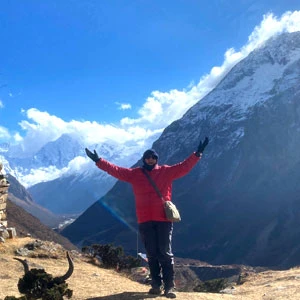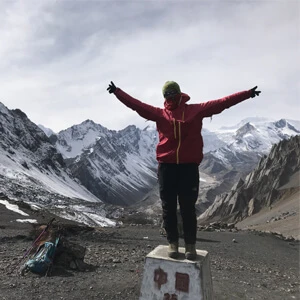Dhaulagiri Circuit Trek Overview
Dhaulagiri’s remote setting and physical demands are well suited to experienced trekkers with a deep sense of adventure and the requisite fitness levels to enjoy the challenge of one of the most extraordinary treks in Nepal. It’s a trek for those who are prepared to test the limits of their endurance on all levels, with little of the comforts offered by the more popular teahouse trails that the majority of trekkers take for granted these days. It’s traditional trekking at its finest, a throwback to a bygone era of expeditions and porters winding their way amidst towering snow-capped peaks, across glaciers, and over high passes used for centuries for trading purposes and to connect to neighboring valleys.
The Dhaulagiri Circuit Trek is a journey few undertake, yet for those with the confidence and ability to take it on, the rewards are many, not least the opportunity to travel through one of Nepal’s most dramatic and scenic regions in almost complete isolation from the numbers typically associated with the more popular trekking routes. Along the way, the trail courses through lush landscapes, terraced fields miraculously carved out of the foothills, and remote valleys seemingly forgotten in time and sparsely populated, with ever-curious children waiting to bestow their beaming smiles on the next stranger to pass through their villages. Formidable Dhaulagiri gazes down from on high throughout, with the Annapurna massif nearby lending its daunting presence, together with over a dozen other peaks of 7,000 meters or more ranging along the trail. Adding even more to the drama are not one but two high passes en route, ready to test each trekker’s mettle.
From Pokhara, the trek commences at the village of Beni and trails along next to the Myagdi River as it tumbles down through the dramatic scenery of the Kali Gandaki gorge. It continues steadily, winding upwards through a series of picturesque Gurung villages towards Italian Base Camp, where we typically pause for an appropriate rest day before hiking out again, this time to the spectacular setting of Dhaulagiri Base Camp, with a night at Glacier Camp along the way. Following another rest day, the route summits at French Pass (5,360 meters) before dropping down into the aptly named Hidden Valley, then throws in a final test of stamina by climbing again to the trek’s exit point, Dhampus Pass (5,234 meters). From there, the trail links to the Annapurna Circuit and wanders down to the completion point at Jomsom and the return leg to Pokhara.
While our itinerary is a well-thought-out approach based on our many years of experience, we’re well aware that experienced trekkers sometimes prefer to set their agenda, and we’re more than willing to accommodate those wishes and perhaps add our suggestions.
So if you’re up for the challenge, are physically fit, and want to experience one of the great treks in Nepal before the inevitable tea houses take hold, why not get in touch with us and let our well-trained guides accompany you on your Himalayan adventure? They’re up for Dhaulagiri Circuit Trek if you are.
On top of the Dhaulagiri Round Trek, similarly, you may consider the Everest Three High Passes Trek, Manaslu Circuit Trek, or the Kanchenjunga Circuit Trek.
Dhaulagiri Base Camp Trek Difficulty
This beautiful journey set against the awe-inspiring backdrop of the Dhaulagiri Massif is a true test of endurance and adventure for seasoned trekkers. The Dhaulagiri Base Camp Trek is an exhilarating adventure that is both technical and challenging. If you wish to trek along the trails to the foothills of the world’s seventh-highest peak, then be prepared for the continuous roller coaster of extreme contrasts.
Starting slow with the reputation for being one of the most challenging treks in Nepal, the Dhaulagiri Round Trek is indeed a long journey that takes around 18 days to complete. During this trek, you will walk an average of 6 to 8 hours each day continuously.
To add further, the trails you will be trekking on are dynamic. In fact, you will walk through dense, lush forests, across rocky moraines, and over high mountain passes, where each segment presents its own set of hurdles. Additionally, since the trail has multiple mixes of narrow, steep ascends and precarious descents, you will have to be extra careful with your footing.
For instance, during the trail in the high-altitude forests, you will come across multiple exposed tree roots, which may cause accidental slips. Likewise, the crossing of the French Pass has rocky moraine and is loose in some places hence, you should also have technical skill and agility to successfully get past it. Similarly, the trails on the Dhampus Pass are sustained at around 30 degrees and are not too exposed, making it hard to trek and ascend, especially during the Winter or early Spring.
Apart from the varied landscapes you will encounter, the Dhaulagiri Circuit Trek takes you to a high-altitude section. While you will spend most of your trek above 2,500 meters, the highest this journey will take you is at an elevation of 5,360 meters at the French Pass.
With the altitude reaching to that extreme, the air starts to get thinner and the altitude sickness looms large with every ascent. Some early symptoms of Acute Mountain Sickness include fatigue, shortness of breath, dizziness, and nausea. Therefore, trekkers must carefully pace themselves, allowing time for their bodies to adjust to the reduced oxygen levels, and be prepared for the physical strain of high-altitude trekking.
Lastly, the Dhaulagiri Circuit Trek takes you to an isolated region with limited access to amenities. While the isolated nature does provide tranquility during the journey, it also asks trekkers to be self-sufficient, carrying all necessary supplies and gear. Therefore, as the logistics are sparse due to its remote location, you will have to camp for half of the trekking days.
This involves not only carrying camping gear but also managing the cold and potentially harsh weather conditions at high altitudes. Altogether, this mixed idea of trekking with tents and staying in tea houses amidst such breathtaking landscapes is both exhilarating and demanding. As demanding as this journey is, the Dhaulagiri Circuit Trek provides a unique connection to the natural world but also tests your resilience and adaptability.
Best Time For High-Altitude Dhaulagiri Trek
The High-Altitude Dhaulagiri Trek is quite popular for its narrow trails that require not only physical strength but also technical capability. Therefore, timing is crucial for this journey. At Nepal Trekking Experts, we recommend you embark on this journey in Autumn (September to November) and Spring (March to May).
Without a doubt, the Autumn is a peak season for trekking in Nepal. Spanning from September to November, this time of the year brings crisp, clear air and excellent visibility, making it ideal for taking in the breathtaking panoramic views of the Dhaulagiri Massif and surrounding peaks. Autumn is known for typically dry conditions and minimal precipitation which gives moderate temperature. This favorable condition makes it easy to navigate and get through the trails.
Likewise, Spring is another favorable trekking season of the year that brings stable weather conditions with clear skies and moderate temperatures. Additionally, it is one of the most beautiful seasons as the forests are in full bloom of rhododendrons and other multiple wildflowers.
Furthermore, the trails are less crowded during Spring compared to the Autumn season. Altogether, this season provides a great balance of good visibility and manageable weather, which enhances the trekking experience and allows trekkers to fully appreciate the stunning Himalayan vistas.
While the Spring and Autumn seasons are mentioned as the best time of the year for this trek, the other seasons; Monsoon / Summer and Winter bring additional challenges to the journey. The unpredictable weather conditions are quite common during the seasons.
During Monsoon / Summer, the whole nation experiences a heavy downpour including this trail which gives rise to the risks of potential landslides and floods. This season spans from June to August and during these times, the trails are muddy and slippery, making it hard to navigate. Additionally, the swollen Myagdi River poses an additional danger during the trek.
Before you think of trekking during Monsoon, you should ask yourself a simple question; Would I want to camp in the rain? It is far-fetched knowing the list of other challenges of the season, but it will surely help you decide. All in all, the Monsoon season offers you little to no visibility of the stunning views due to persistent dark clouds filled with rain.
On a similar note, the Winter season also visits with its own set of baggage. While the idea of snow-clad peaks with snow all over the valley and trail might paint a gorgeous picture in your mind, it should be known that this time of the year brings the coldest days.
Indeed, the temperatures are well below freezing point, especially at higher altitudes and the trail faces constant snowfall. This continuous snow makes some passes impassable and the trails more hazardous. Similar to the Monsoon season, the trails in the lower altitude get slippery but this time with patches of snow and ice.
Permits
Embarking on the Trek to Dhaulagiri Circuit requires two crucial permits: the Annapurna Conservation Area Permit (ACAP) and the Dhaulagiri Restricted Area Permit. These permits are essential for ensuring that trekkers adhere to the regulations designed to protect the region’s natural beauty and cultural heritage while also managing access to more sensitive and remote areas.
The Annapurna Conservation Area Permit (ACAP) is required as the trek starts from the Annapurna region and it will cost you NRs 3,000 per person. Likewise, the Dhaulagiri Restricted Area Permit (RAP) is needed to enter the Dhaulagiri region and it will cost you USD 20 per person per week.
Here, getting these permits is quite a straightforward process as you can get them from a registered local trekking agency or the Nepal Tourism Board office in Kathmandu. For the ACAP, a valid passport and passport-size picture will be enough. As for the RAP, you will also need to submit a detailed itinerary and proof of travel insurance. Also, you can only enter the area with a guide.
How can I book the Off-the-beaten-path Dhaulagiri Trek?
To book your trek with us, you have to send a 10% deposit of the total cost. Please also forward a copy of your passport, a passport-sized photo, and full flight details if and when available. For your convenience, you may forward the deposit online through our website. It is completely safe, and as soon as you make it, you will get an automatic receipt in your inbox. The rest of the payment can be paid upon arrival.



 based on 16 reviews
based on 16 reviews



